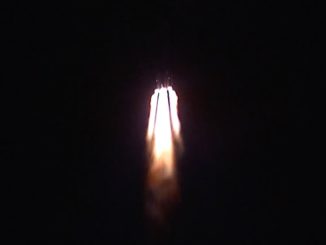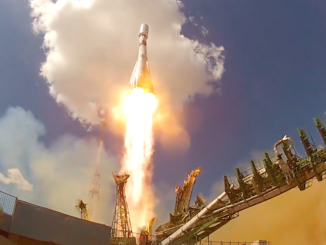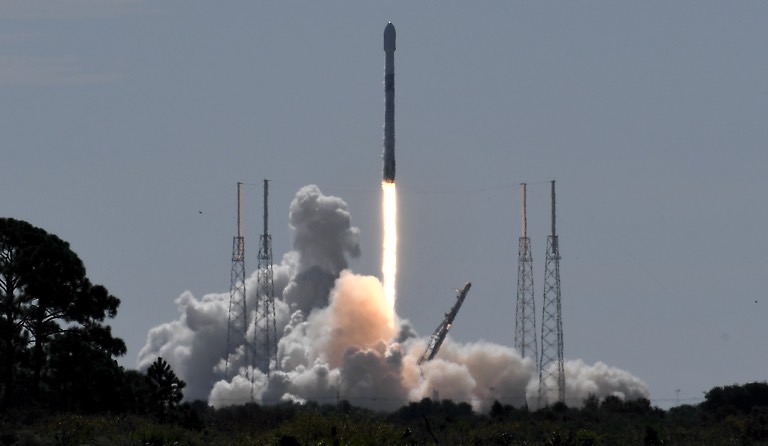
A Falcon 9 rocket loaded with 58 more broadband relay nodes for SpaceX’s Starlink Internet network took off Tuesday from Cape Canaveral, bringing the total number of Starlink craft launched since May 2019 to 653 satellites.
The reusable Falcon 9 booster that powered the 58 Starlink satellites toward space was making its sixth flight, setting a new record for SpaceX’s liquid-fueled rocket family.
The fresh Starlink craft launched Tuesday widened SpaceX’s lead in fielding the largest fleet of satellites, and also added to the constellation of Earth-imaging satellites owned by Planet. Planet’s satellite fleet is the second-biggest after SpaceX’s Starlink network.
Three commercial SkySat Earth observation satellites hitched a ride into orbit on the Falcon 9 rocket, joining around 150 other small spacecraft in the Planet’s fleet.
The mission began with a fiery takeoff from Cape Canaveral’s Complex 40 launch pad at 10:31:16 a.m. EDT (1431:16 GMT) Tuesday, kicking off SpaceX’s 14th Falcon launch of the year, and the 99th flight of the company’s Falcon rocket family since 2006.
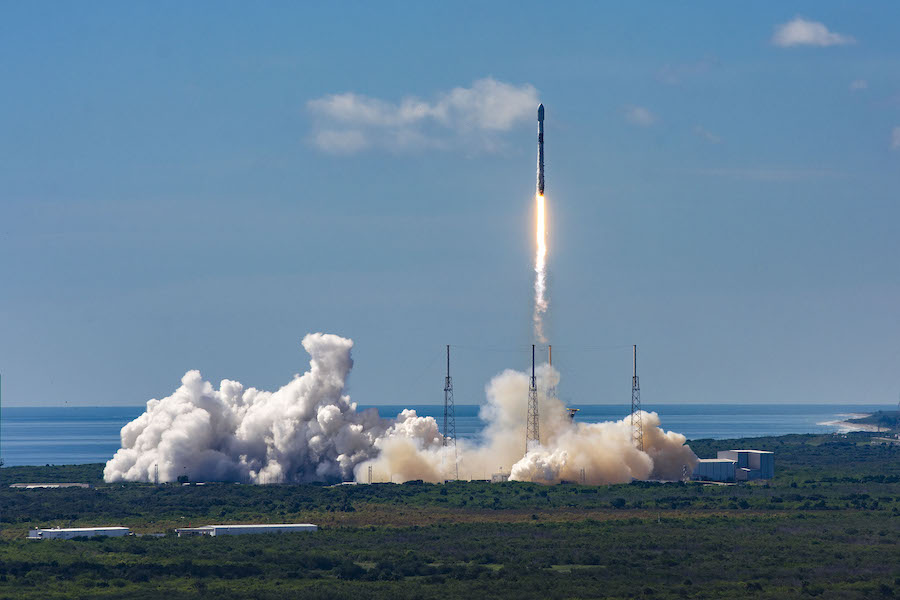
The 229-foot-tall (70-meter) rocket turned northeast from Cape Canaveral after blasting off from pad 40, flying on a course roughly parallel to the U.S. East Coast to align with the Starlink satellites’ planned orbital inclination of 53 degrees.
Two-and-a-half minutes after liftoff, the Falcon 9’s first stage shut down its nine Merlin engines and separated to begin a descent toward SpaceX’s drone ship “Of Course I Still Love You” positioned in the Atlantic Ocean around 400 miles (630 kilometers) northeast of Cape Canaveral.
After ignition of the Falcon 9’s upper stage engine, the rocket shed its clamshell-like payload shroud at T+plus 3 minutes, 12 seconds. The two halves of the nose cone came back to Earth under parachutes for retrieval by a pair of SpaceX recovery boats.
The 15-story first stage nailed its return to SpaceX’s offshore landing platform nearly nine minutes after liftoff, completing its sixth round-trip flight to space and back. That’s a new record for SpaceX’s fleet of Falcon boosters, which previously had flown no more than five times a piece.
Designated B1049 in SpaceX’s fleet, the booster used on Tuesday’s mission first flew from Cape Canaveral in September 2018 in the launch of Telesat’s Telstar 18 VANTAGE communications satellites. After landing on a SpaceX drone ship, the booster launched again from California in January 2019 with 10 Iridium voice and data relay satellites, and again returned to a propulsive touchdown on an offshore recovery vessel.
The Falcon first stage launched three more times with satellites for SpaceX’s Starlink broadband network, most recently on June 3. SpaceX says the Falcon 9’s first stage booster is capable of at least 10 flights without a major overhaul, though engineers perform routine inspections and refurbishment between each mission.
SpaceX later confirmed one of the two halves of the payload shroud used on Tuesday’s launch was successfully caught by a net aboard one of the company’s two fairing recovery vessels. The other fairing clamshell parachuted into the Atlantic Ocean and will be retrieved for return to Cape Canaveral, SpaceX said.
The fairing on today’s mission was reused from a previous Falcon 9/Starlink launch.
The Falcon 9’s upper stage delivered its 61 satellite passengers into an on-target elliptical, or egg-shaped, orbit around Earth ranging in altitude between 128 miles (207 kilometers) and 229 miles (370 kilometers). The three SkySats, mounted on top of the Starlink satellite array, separated at 30-second intervals beginning about 12-and-a-half minutes into the mission.
After flying halfway around the world, the upper stage released the 58 Starlink payloads over the Indian Ocean about 46 minutes after liftoff.
The 58 Starlink satellites launched Tuesday brings the network closer to providing initial Internet services.
SpaceX’s previous launch on Aug. 7 delivered 57 Starlink satellites to orbit, along with a pair of Earth-imaging microsatellites for BlackSky, a competitor of Planet in the commercial remote sensing market.
Beginning with the Starlink launch earlier this month, SpaceX says all of the Starlink satellites are equipped with sunshade visors to reduce their reflectivity, a measure aimed at mitigating concerns that thousands of Starlink spacecraft might interfere with astronomical observations using ground-based telescopes.
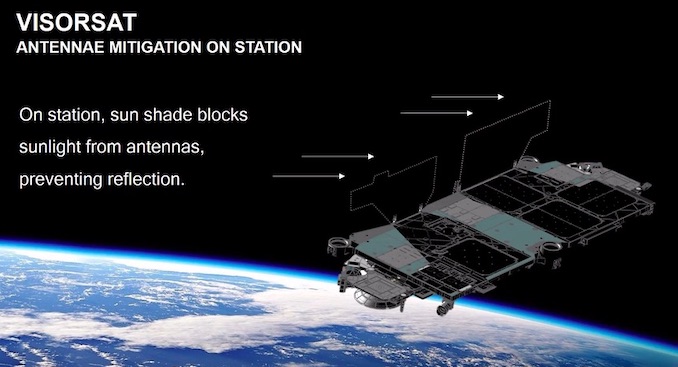
SpaceX’s Starlink network is designed to provide low-latency, high-speed Internet service around the world. Elon Musk, SpaceX’s founder and CEO, also views the Starlink program as a means to earn revenue to help fund the company’s lofty ambitions to develop a next-generation reusable rocket known as Starship, which Musk says could eventually carry people to the moon and Mars.
Each of the flat-panel Starlink satellites weighs about a quarter-ton, and are built by SpaceX in Redmond, Washington. Once in orbit, they will deploy solar panels to begin producing electricity, then activate their krypton ion thrusters to raise their altitude to around 341 miles, or 550 kilometers.
SpaceX says it needs 24 launches to provide Starlink Internet coverage over nearly all of the populated world, and 12 launches could enable coverage of higher latitude regions, such as Canada and the northern United States.
The three Planet-owned Earth observation satellites deployed in orbit Tuesday are the last three of 21 SkySat high-resolution reconnaissance platforms the San Francisco-based company plans to launch.
The SkySats join 18 others Planet has launched aboard U.S., European and Indian rockets since 2013, supplying regularly-updated sharp images of the world’s cities, forests, farms, waterways, and other regions of interest to government and commercial users.
Planet confirmed its ground team acquired the first radio signals from all three satellites minutes after Tuesday’s launch, confirming the spacecraft were alive and well in orbit.
The SkySats offer Planet’s customers high-resolution views of Earth, while a flock of more than 100 smaller Dove CubeSats provide wider area coverage at lower resolution.
Planet launched three identical SkySats on a Falcon 9/Starlink launch June 13, and the three new spacecraft launched Tuesday will bring the SkySat fleet to 21 satellites.
Built by Maxar, each SkySat satellite is about the size of a dishwasher and weighs about 242 pounds (110 kilograms) at launch.
Beginning in 2013, the first 15 SkySat satellites launched into polar sun-synchronous orbits and fly in in north-south paths around Earth. Sun-synchronous orbits are popular for remote sensing and environmental satellites because they allow regular imaging of the Earth’s surface with the sun at the same angle.
Around half of the SkySats fly in orbits timed to fly overhead in the morning, and the other half soar over imaging targets in the afternoon, providing coverage of certain parts of the globe twice per day.
The three SkySats launched Tuesday are the last of a block of spacecraft ordered from Maxar, formerly known as SSL, by Skybox Imaging. Skybox was acquired by Google and renamed Terra Bella in 2014, then Planet acquired Terra Bella and the SkySat assets in 2017.
The SkySats taking off on rideshare missions with SpaceX’s Starlink satellites fly at a lower-inclination orbit inclined 53 degrees to the equator. Planet says the new satellites “will offer more targeted coverage and raw image capacity in key geographic regions.”
“By taking advantage of SpaceX’s rideshare program, we were able to get these satellites launched much faster compared to a dedicated launch,” wrote Mike Safyan, Planet’s vice president of launch, in a blog post on the company’s website.
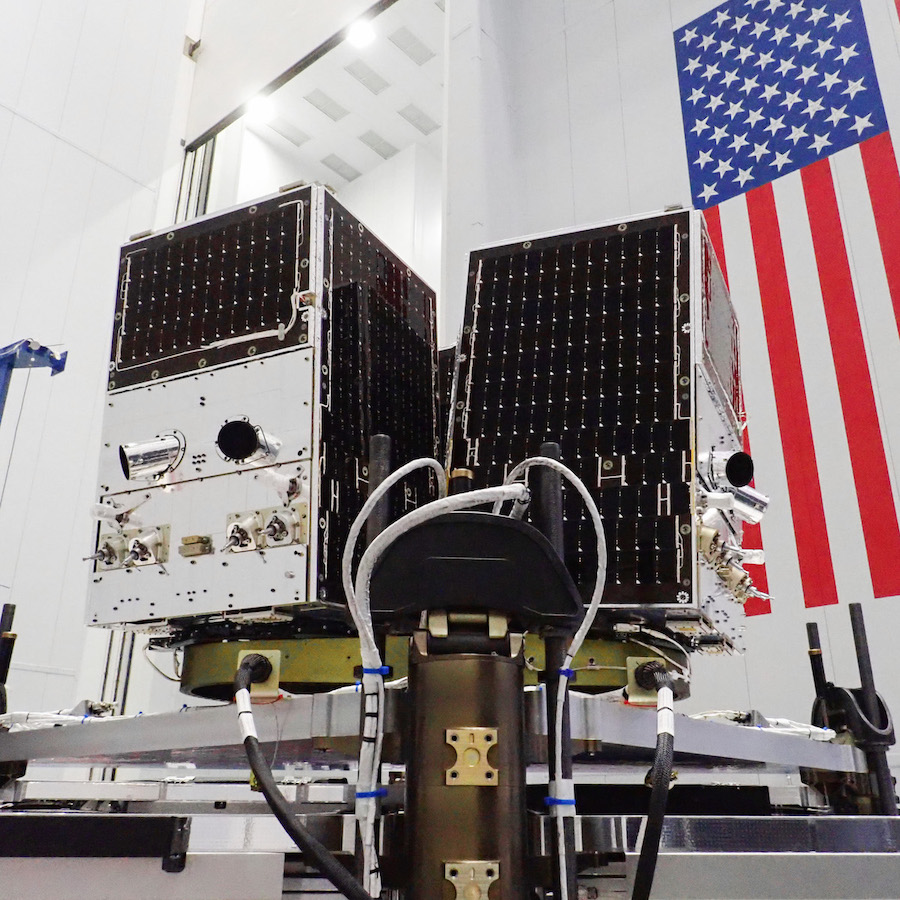
The SkySats will use their own propulsion to maneuver from the Starlink injection orbit to an operating altitude of around 250 miles (400 kilometers).
At that altitude, the SkySats will be able to produce images of Earth at a resolution of less than 20 inches, or 50 centimeters. Planet announced it has also lowered the orbits of its SkySats already in space to allow the collection imagery of the same quality.
In an interview with Spaceflight Now in June, Safyan would not disclose what Planet paid SpaceX to launch the six SkySats, SpaceX has published pricing for rideshare launch services on its website. The company lists a price as low as $1 million for a 440-pound payload on a rideshare to a polar sun-synchronous orbit.
“That’s incredibly competitive pricing,” Safyan said in June. “Coupled with the fact that the Falcon 9 is one of the world’s most reliable and well-flown vehicles out there, and they’re going to a variety of orbits very regularly, makes it a very attractive offering.”
The SkySats are designed for six-year missions, according to Planet. There are no more SkySats currently in production by Planet and Maxar.
“That gives us a pretty long runway with respect to what these SkySats will be able to provide,” Safyan said in June. “We’re looking at the future of high-res at Planet. It’s still too early to talk about the details of that. But we will continue to offer both medium-res and high-res products to our customers.
“One of the promises that Planet always makes to its customers is that our products get better over time,” Safyan said. “We don’t like to rest on our laurels. We really like to listen to the market and understand what are they evolving needs, especially as we grow the customer base.
“It’s not just industries that are traditional users of remote sensing, like government agencies and agriculture,” Safyan said said. “There are newer markets that are being opened up in finance and insurance, so better understanding those market needs as well helps us inform how we develop the product going forward. Because we’re vertically-integrated, that gives us a really big advantage of being able to take customer feedback and actually incorporate that into satellite design and operations.”
Email the author.
Follow Stephen Clark on Twitter: @StephenClark1.

